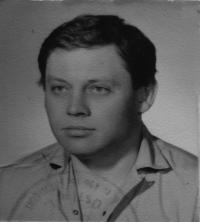The situation in Poland was quite hopeful for us, but when you’re wearing a uniform, that’s trouble. It seemed they were actually capable of sending us there.

Download image
František Kotyz was born on 19 February 1956 in Hradec Králové. When the Scouting Movement was renewed in 1968, he was accepted into the 6th Troop, “Wolf Pack”. In 1980 he graduated from hydrogeology at the Faculty of Natural Sciences of Charles University. In September that year he began his compulsory military service, and in December he participated in the Krkonoše 1980 field exercise. After being released from the army in September 1981, he started working as a mine hydrogeologist at the uranium mines in Stráž pod Ralskem. In November 1989 he took part in demonstrations against the regime. In the years 1997 to 2014 he worked at Ochrana podzemních vod (Groundwater Protection), in 2015 he switched to SG geoprůzkum (SG Geo-Survey).

